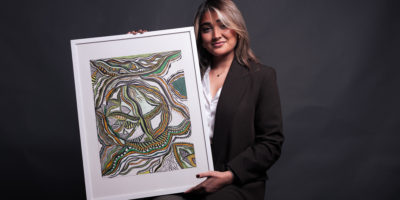By Sonia Kuczaj
Dressed in a long-sleeved blue shirt, black trousers and plain-looking glasses, Ernie Gehr looks more like a friendly uncle with a receding hairline than the legendary experimental filmmaker of the 1960s. As he stands in the back of Ryerson’s Eaton Lecture Theatre of the Rogers Communications Centre on Friday night, Geher blends in with the packed crowd of 150 students, faculty and film fans who are watching a screening of his latest films. But like his no-frills appearance, Gehr is down-to-earth and not at all pretentious. The soft-spoken filmmaker begins his lecture by saying, “I’d rather have the films speak for themselves.”
Unlike the image arts students he spoke to, Gehr never went to film school. He is self-taught and began making films on an 8mm camera in 1966. In 1967, he began using a 16mm.
In one of the films screened at the lecture, Side/Walk/Shuttle, Gehr expresses the displacement he felt when moving from New York to San Francisco. He shot scenes of San Francisco streets while riding an outdoor glass elevator in The Fairmont Hotel. The hotel never granted him permission to shoot there, so he disguised himself and hid his 16mm hand-held Bolex camera under his coat. Gehr was escorted out of The Fairmont so often, it took more than a year to shoot Side/Walk/Shuttle.
Gehr began his film career in his twenties as part of New York’s experimental film movement of the 1960s. His introduction to the avant-garde style was a 1966 viewing of an experimental film by Stan Brakhage. “In the sixties I discovered another cinema where I could make films without a 35mm, professional crew, script, big budget,” says Gehr. “I could pick up amateur film equipment and film whatever I wanted to.”
Throughout the late 1960s and up the early 1970s, Gehr supported what he refers to as his “habit” by working at various office jobs. He received his first film grant in 1974 and today he is a faculty member at the San Francisco Art Institute. But for Gehr, filmmaking is more a compulsion than a career.
“Film is part of me, it’s part of my existence,” he says. “The rewards have always been more psychological than economical.”
Gehr makes films about things he is amused by, troubled by and needs to understand. But ever as a child he had his own take on cinema. He remembers going to matinees in old movie houses and being fascinated by the smoke and dust particles captured in the light beaming from the film projector.
Gehr’s dedication to his craft is what makes image arts students such as photography major Samantha Rajasingham great admirers of his work. Rajasingham, along with some of the other faculty members, had dinner with Gehr the Wednesday he arrived, on Nov. 1. Rajasingham says meeting Gehr was terrifying, “but Ernie was lovely, approachable, warm, a great man of art and yet humble. It is that tremendous sense of engagement in his craft, his love for it that it so compelling.”
Rajasingham became intrigued with Gehr after image arts teacher Bruce Elder introduced her to avant-garde cinema. She remember reading up on avant-garde filmmakers when she came upon this quote describing Gehr’s work by Hollis Frampton: “Of a film seen on my third birthday I recall only this: a drenching radiance, like the sun’s, made somehow carnally intimate. Thirty years later I recovered that ecstasy in the films of Ernie Gehr.”
But those who have an understanding of media arts may harbour a deeper appreciation of Gehr’s work. “I am a photographer and I certainly enjoyed the screening,” say Bob Burley, coordinator of the Kodak lecture. “Especially of Side/Walk/Shuttle. It was amazing. It showed me thing I never thought about before.”
One of Gehr’s most moving pieces was Rear Window, in which he films clothes hanging on a line in various shades of light. The film captures the emotional turmoil Gehr felt after his father passed away.
Burley refers to Gehr as an original who has continued to develop new ideas for film over the past 30 years. And Gehr might continue doing so for another 30 years. “I’d be miserable if I wasn’t making things,” he says. “It makes it possible to breath, a reason for existing.”











Leave a Reply